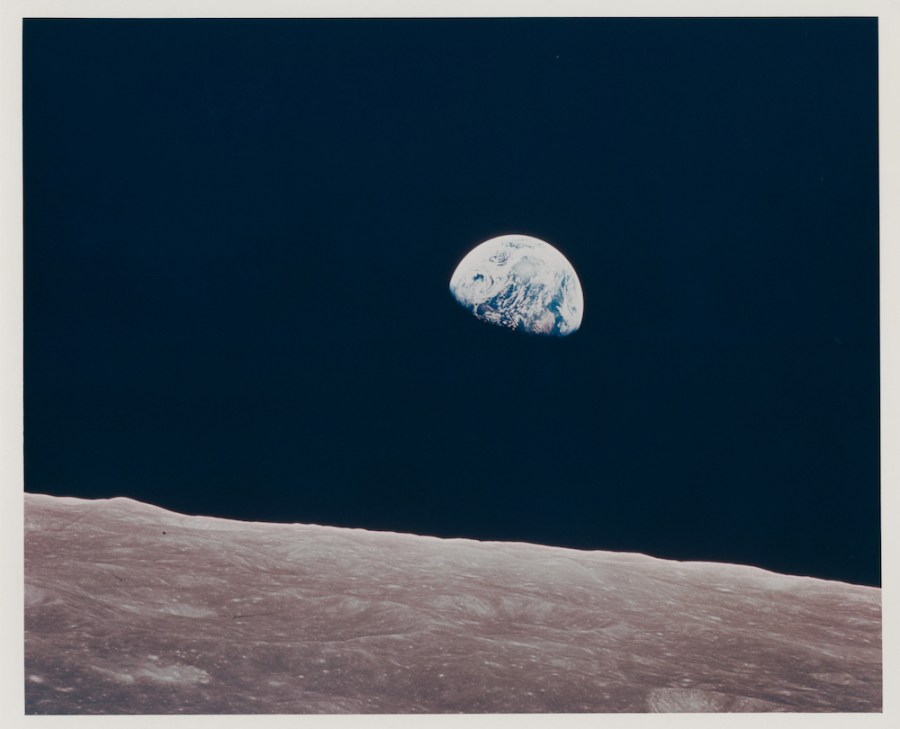Dozens of iconic images from NASA’s Apollo space programme are going under the hammer at the Bruun Rasmussen auction house in Copenhagen on 9 March 2022.
A total of 74 NASA photographs from the Apollo 8 to 17 missions, including the world’s first image of Earth from space and the first astronauts to walk on the moon, will be up for auction at 2pm on 9 March. The images come from a private collection and have a pre-sale estimated value of DKK 1.5 million (approx. £168,000).
All the astronauts participating in NASA’s lunar missions were equipped with adapted, state-of-the-art Hasselblad cameras to capture the new and previously unseen world and to document this highpoint in human endeavours. Photography was a vital tool for NASA to publicise its activities and to help to justify the US government’s spending on space programmes. You can find out more about the role photography played in NASA’s Apollo missions.

The first colour photograph of the first ‘Earthrise’ witnessed by humans
National Geographic and LIFE covers
Several of the collection’s photographs have belonged to NASA’s own archives and were not known to the public. Carefully selected copies of the photographs were, at the time, published on the front pages of major, influential magazines such as National Geographic and LIFE to tell the world about the United States’ success in the lunar race. The auction includes three iconic photographs that made it to the covers in 1969. Furthermore, 27 of the photographs have been published inside the two magazines.
On the cover of National Geographic, December 1969, the words ‘First Explorers on the Moon’ were printed across the auction’s photograph of the Moon’s first explorers: the moonwalking Buzz Aldrin in full astronaut gear and Neil Armstrong, who photographed Aldrin and can be glimpsed in the reflection of Aldrin’s gold visor. The same photograph also graced the cover of a special August 1969 issue of LIFE and is the most famous image of a human on the Moon. Here’s the story of Neil Armstrong’s iconic photograph ‘Man on The Moon’ (shown below).
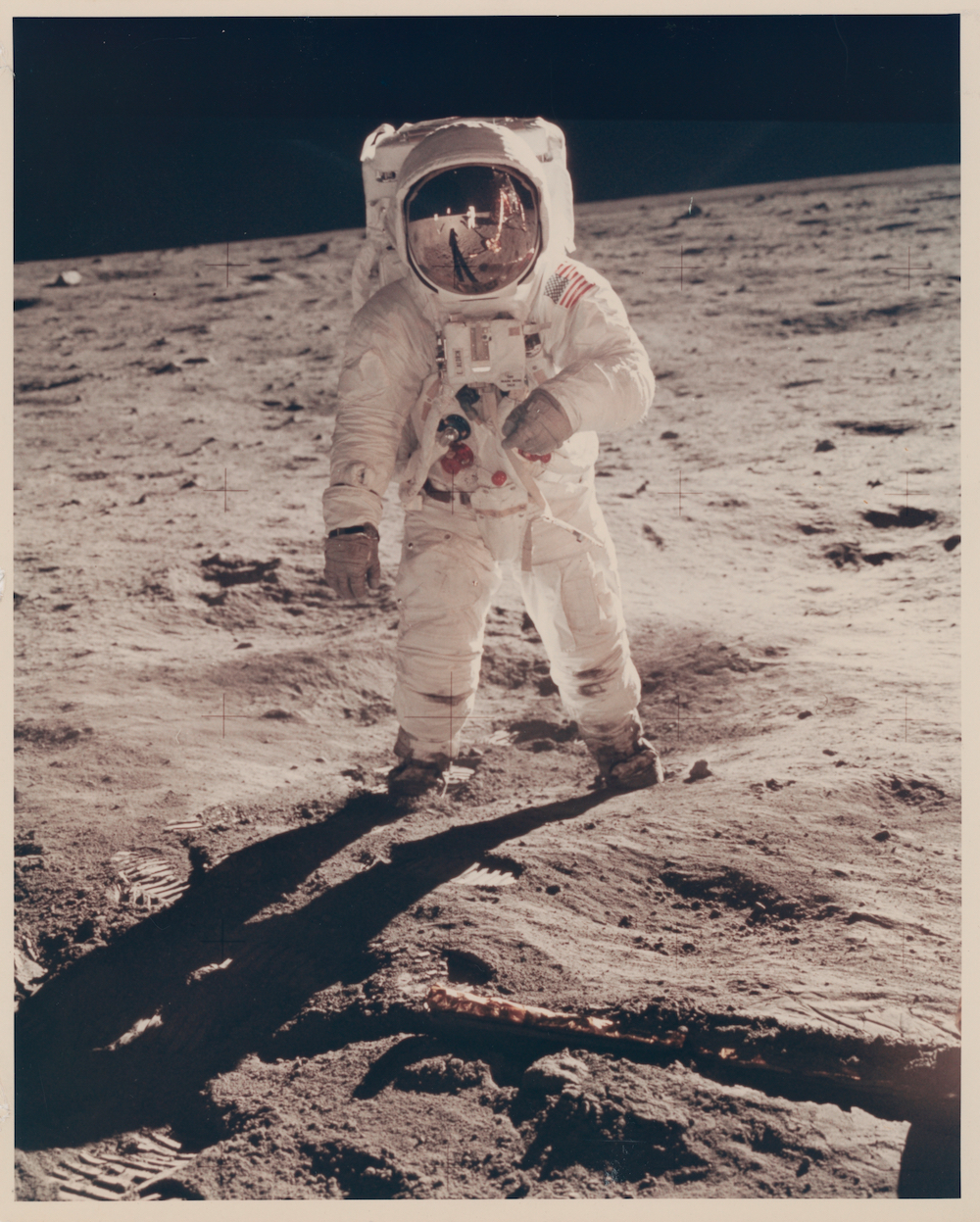
Buzz Aldrin’s gold-plated sun visor reflects the photographer, Neil Armstrong, and the LM Eagle landing craft
LIFE also had two other covers with photographs that are now up for auction. One that graced the cover of LIFE magazine, 10 January 1969 issue, is the very first photograph of the Earth taken by a human. The photographer was astronaut William Anders (Apollo 8) and the image shows the beautiful marble-like planet floating in space with the headline ‘The incredible year ’68’. The second LIFE cover, dated 8 August 1969, shows a photograph of the American flag placed on the surface of the Moon, as a symbol of the conquest of the new world by man, or more particularly the Americans, with the simple caption stating ‘On the Moon’.
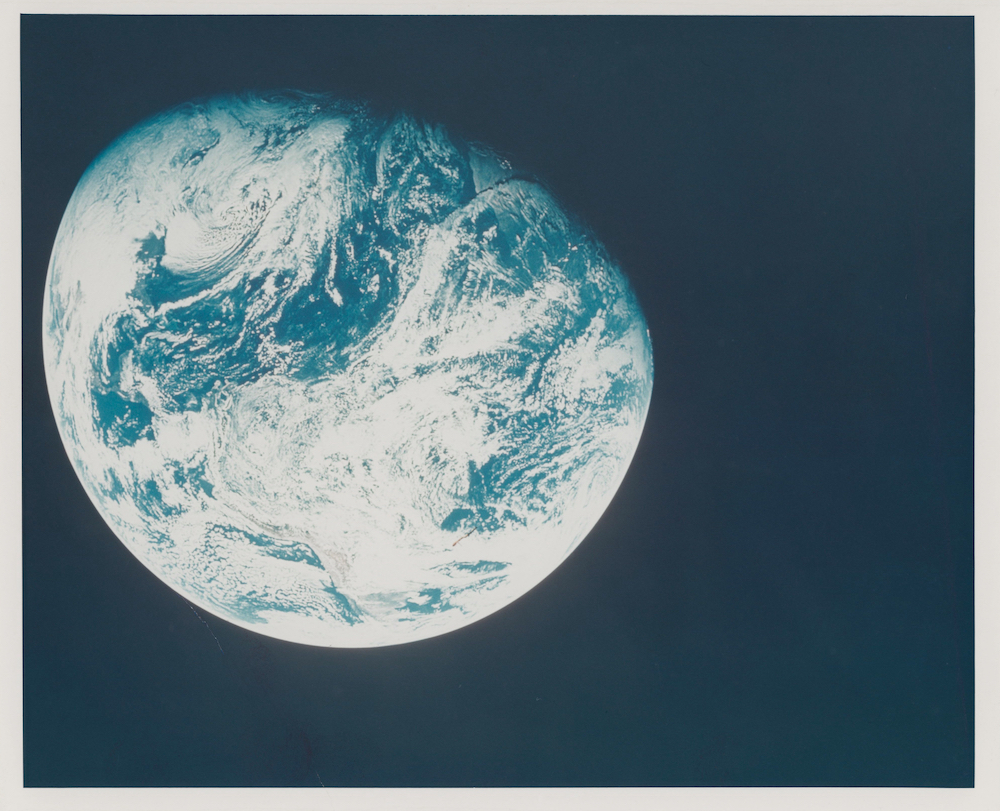
The first human-taken photograph of planet Earth, shot by William Anders onboard Apollo 8
Lærke Bøgh, head of department and specialist at Bruun Rasmussen, explained, ‘It was truly a time of greatness, and there was a sense of incredible accomplishment because we as humans had succeeded in making it to the Moon. A belief in our own abilities and a sense of limitless potential abounded in society, and despite the crises that also existed during that time, humanity achieved some of the greatest things within space exploration – putting a human on the Moon. The spirit of the times and the world history that was written during this period shines through clearly in the photographs. Knowing that these are the original photographs taken by the astronauts during the biggest missions of their lives presents a great thrill in this digital age.’

This photograph of the American flag on the Moon was on the cover of LIFE magazine in August 1969
60th anniversary of President Kennedy’s speech
This year marks the 60th anniversary of US president John F. Kennedy’s famous 1962 Moon speech, when he said, ‘We choose to go to the Moon in this decade and do the other things, not because they are easy, but because they are hard; because that goal will serve to organise and measure the best of our energies and skills, because that challenge is one that we are willing to accept, one we are unwilling to postpone, and one we intend to win, and the others, too.’
His inspiring words in 1962 were not just about the vision of putting humans on the Moon, but about galvanising the spirit of the times where everything seemed possible for mankind. The auction also includes photographs of Kennedy’s final visit to NASA at Cape Canaveral on 16 November 1963, just six days before his tragic death.
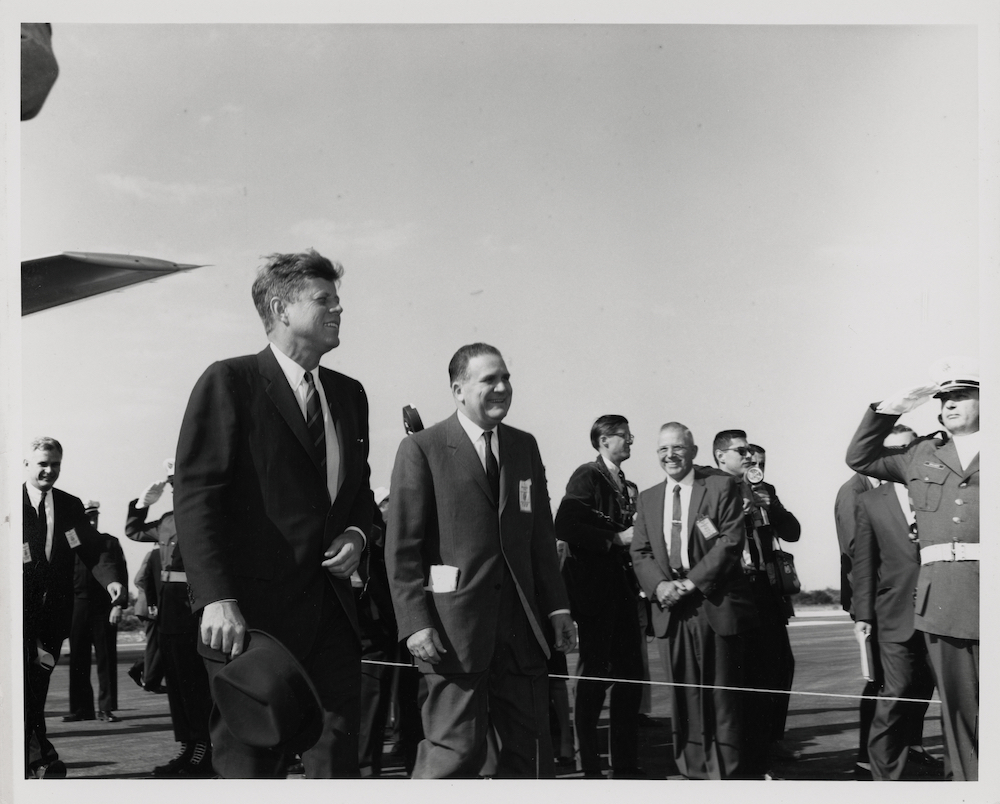
US President John F. Kennedy visiting Cape Canaveral, 16 November 1963, six days before he was assassinated
The auction’s photographs include the beautiful photograph of the Apollo 11 command module floating over the Sea of Fertility, the allegorical close-up of an imprint made by Buzz Aldrin’s boot in the Moon’s dust and an extraordinary panorama of a giant lunar canyon.
The Apollo programme
The idea behind the Apollo programme was to get the first human safely to the Moon and back again to Earth. Between 1968 and 1972, a series of more or less successful Apollo missions were launched by NASA. On several of the missions, the spaceships managed to enter the lunar orbit, and on the famous Apollo 11 in 1969, they finally landed on the Moon.
At the auction, photographs from all the major Apollo milestones are presented: from Apollo 8 with a photograph of the Saturn V, which was the first rocket to get man out of Earth’s orbit and towards the Moon, over Apollo 11 with the very first image of a human on the Moon, to Apollo 17 with a photograph of the last human to set foot on the celestial body.
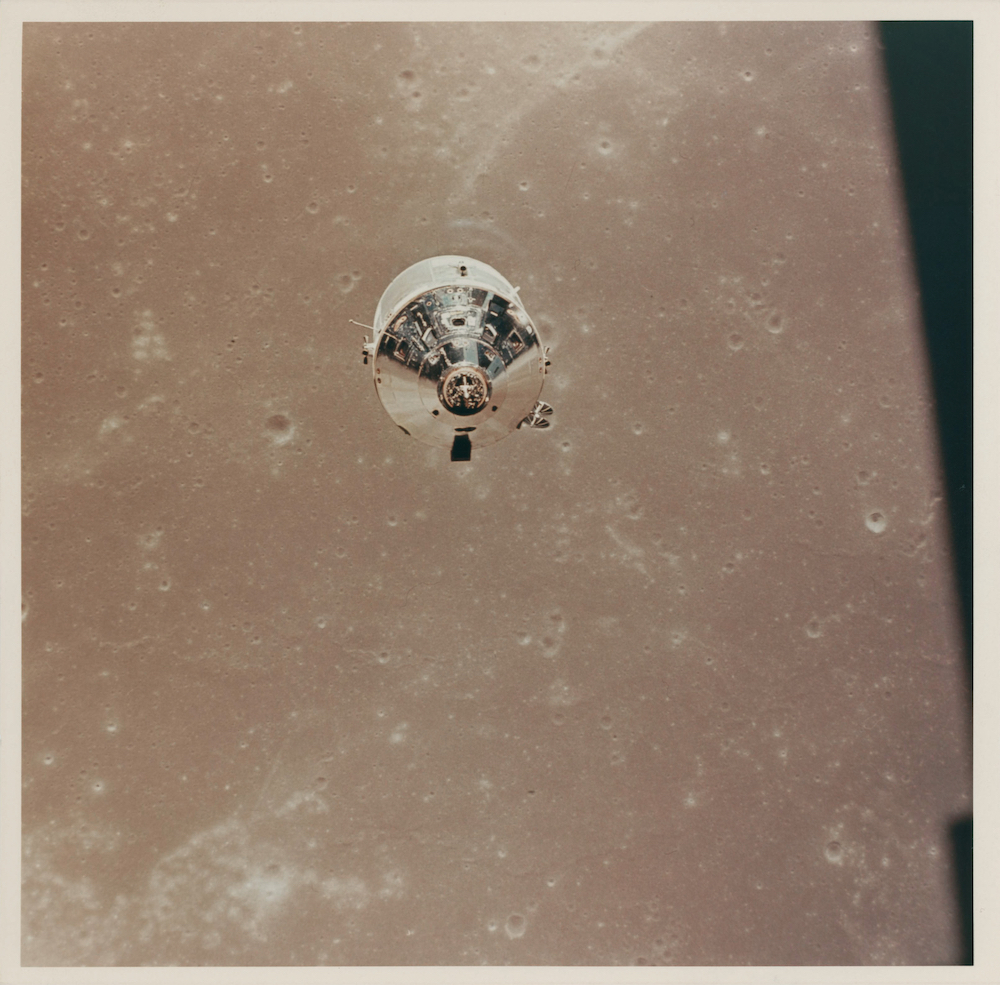
The Command and Service Module (CSM) Columbia over the Sea of Fertility, as seen from the LM descending to the lunar surface
On their world-changing journeys NASA’s astronauts were equipped with the latest, specially adapted, Hasselblad cameras to visually document what they were experiencing. They were instructed in the use of the cameras by NASA, Hasselblad, Kodak, Zeiss specialists and photographers at LIFE and National Geographic magazines.
All of the photographs in the auction are original and were developed in limited numbers. Several are so-called ‘NASA red numbers’ (original chromogenic colour prints direct from NASA) and ‘NASA black numbers’ (original monochrome prints direct from NASA). Other images in the auction have original NASA captions and vintage Kodak watermarks indicating that they were developed right after each mission took place.
Find out more…
You can get a closer look at all the photographs at Bruun Rasmussen’s preview from 24-28 February 2022. The opening presentation of the preview includes a talk about the NASA photographs by specialist Lærke Bøgh on 24 February at 4pm.
You can discover more about the auction and the stories behind each photograph in at the Bruun Rasmussen auction house website.
Related articles:
Apollo 11 anniversary special: the role photography played
Apollo 11 anniversary special: the first camera on the moon

